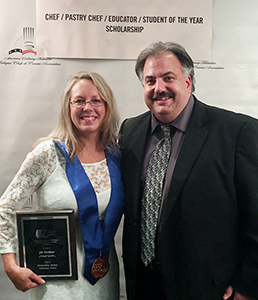Mayo’s Clinic: Assessment Criteria and Rubrics
 In his final installment in a series on student assessment, Dr. Mayo says it is increasingly important to explain to students the criteria we use in grading. Not only does doing so make our jobs easier, but it is only fair to tell students ahead of time how they are going to be evaluated.
In his final installment in a series on student assessment, Dr. Mayo says it is increasingly important to explain to students the criteria we use in grading. Not only does doing so make our jobs easier, but it is only fair to tell students ahead of time how they are going to be evaluated.
By Dr. Fred Mayo, CHE, CHT
Over the last three months, we have discussed the purposes of assessment and assessment methods such as keeping track of attendance, using open-book tests, administering take-home examinations, evaluating oral presentations, grading class participation and observing student performance in culinary classrooms and dining rooms. This month, we will examine assessment criteria and rubrics.
Criteria versus Methods
Many faculty members confuse assessment criteria with assessment methods, understandable since many of us were taught in situations where there were no explicit criteria and the only thing we knew was the grading mix—what percentage of the grade was based on which specific assignments. However, the world of assessment has grown immensely, and the renewed focus on outcomes has led many of us to develop a range of assessment methods and criteria.

 Employers seek graduates who follow directives, have a strong foundation of technical skills and enthusiastically respond, “Yes, Chef.” Yet knowing the “why” and “how to” is as important a skill as the actual process of completing a task.
Employers seek graduates who follow directives, have a strong foundation of technical skills and enthusiastically respond, “Yes, Chef.” Yet knowing the “why” and “how to” is as important a skill as the actual process of completing a task. A free classroom offer to teach students why menuing domestically raised fish and seafood is an important way to keep both customers and the bottom line happy.
A free classroom offer to teach students why menuing domestically raised fish and seafood is an important way to keep both customers and the bottom line happy. Le Cordon Bleu College of Culinary Arts in Los Angeles, Pasadena, Calif., is mourning the loss of a beloved educator. Chef instructor Larry Bressler, 50, and his wife, Denise, 64, passed away on Oct. 13, 2014. Bressler was a longtime instructor and friend to many at Le Cordon Bleu, known as a kind, fun-loving person with as much passion and zest for music as he had for food. He was also the general manager of Chefs Center, a commercial kitchen-rental space that helped launch many successful local businesses. From 1995 to 2003, Bressler was chef and owner of 50-seat Gerard’s, a French bistro in Riverside.
Le Cordon Bleu College of Culinary Arts in Los Angeles, Pasadena, Calif., is mourning the loss of a beloved educator. Chef instructor Larry Bressler, 50, and his wife, Denise, 64, passed away on Oct. 13, 2014. Bressler was a longtime instructor and friend to many at Le Cordon Bleu, known as a kind, fun-loving person with as much passion and zest for music as he had for food. He was also the general manager of Chefs Center, a commercial kitchen-rental space that helped launch many successful local businesses. From 1995 to 2003, Bressler was chef and owner of 50-seat Gerard’s, a French bistro in Riverside. Two chefs have joined the ranks of an elite group of Certified Master Chefs (CMC) following an eight-day exam from Oct. 26 to Nov. 2. The new Certified Master Chefs are:
Two chefs have joined the ranks of an elite group of Certified Master Chefs (CMC) following an eight-day exam from Oct. 26 to Nov. 2. The new Certified Master Chefs are: The Culinary Institute of America has partnered with Cool Culinaria to bring the CIA’s extensive collection of more than 30,000 menus to new audiences in the form of archival prints, notecards, coasters, mugs, tea towels, placemats and other products.
The Culinary Institute of America has partnered with Cool Culinaria to bring the CIA’s extensive collection of more than 30,000 menus to new audiences in the form of archival prints, notecards, coasters, mugs, tea towels, placemats and other products. A student and an instructor from Baker College of Port Huron Culinary Institute of Michigan (CIM) have each received a major award from the Michigan Chefs de Cuisine Association (MCCA), a chapter of the American Culinary Federation (ACF) serving the southeastern part of the state.
A student and an instructor from Baker College of Port Huron Culinary Institute of Michigan (CIM) have each received a major award from the Michigan Chefs de Cuisine Association (MCCA), a chapter of the American Culinary Federation (ACF) serving the southeastern part of the state. Armed with a degree in business, Katie Veile decided not to let her student loans stand in the way of pursuing her lifelong passion at The French Pastry School.
Armed with a degree in business, Katie Veile decided not to let her student loans stand in the way of pursuing her lifelong passion at The French Pastry School.  Vegetarianism—and its many variations—is a way of life for a growing number of Americans. Students, thus, should learn to prepare vegetarian and vegan dishes that entice and excite even those customers who enjoy meat. To that end, Chef Zonka shares her first-week lesson plan in a vegetarian-cuisine course.
Vegetarianism—and its many variations—is a way of life for a growing number of Americans. Students, thus, should learn to prepare vegetarian and vegan dishes that entice and excite even those customers who enjoy meat. To that end, Chef Zonka shares her first-week lesson plan in a vegetarian-cuisine course.